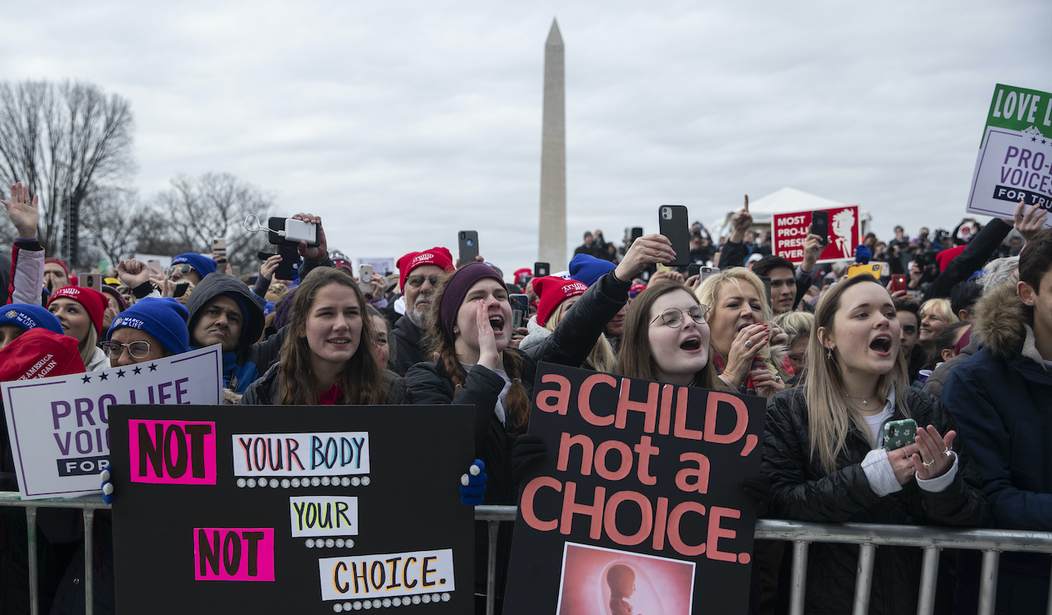On December 1, I stood outside of the United States Supreme Court 21 weeks pregnant, emceeing a rally in support of Mississippi’s pro-life law at the heart of the Dobbs v. Jackson Women’s Health Organization case. The law challenges the court to reconsider Roe v. Wade and its companion cases. During oral arguments inside the Court on December 1, the Mississippi Attorney General defended her state’s “Gestational Age Act,” a law aimed at protecting Mississippi children in utero before the age of “viability.”
This law — and the Supreme Court case it spurred — is especially personal to me as I carry a child inside of me and can feel her moving. At 21 weeks pregnant, I know that my child is fully developed: face, nose, eyelashes, fingernails, brain. Beyond that, she has her own unique set of DNA, distinct from mine and her father’s, and her sex was determined long ago at the moment of her conception. My daughter and all children in the womb deserve protection at every age of development.
But ever since the Supreme Court read an invisible “right” to abortion into the Constitution in 1973, it has been forced to conjure up a stream of arbitrary justifications for why a child in the womb cannot be afforded the same protections as a child or adult outside the womb, including the constantly moving line of so-called “viability,” and has prevented states from protecting their children before the "realistic possibility" that they will survive outside the womb. Mississippi pushed back against the arbitrary standard, which brings us to the Supreme Court this week.
But what does that standard look like in real life? In the nearly 50 years since the seven men on the Supreme Court decided to grant women the so-called “right” to an abortion, the age of prenatal viability has moved from 28 weeks to less than 22 weeks. And with incredible, life-saving advances in medical technology, the age of viability keeps inching earlier and earlier. This summer, Richard Hutchinson was recognized by Guinness World Records as the most premature baby to survive after he was born at 21 weeks, 2 days, weighing less than 12 ounces. Richard's record was quickly replaced the next month by Curtis Means, who was born at 21 weeks, 1 day.
Recommended
Jackson Women's Health Organization, the Mississippi abortion provider that took the state to task over its decision to protect preborn children from abortion, argues in its Supreme Court brief that "[m]edical consensus and the undisputed facts in this case establish that viability occurs no earlier than 23-24 weeks of pregnancy." In other words, abortionists argue that a state cannot protect the child I'm carrying. They say that I have a "constitutional right" to kill my daughter. That's a horrifying thought, and it is even more disturbing when you consider that my daughter, at 21 weeks, is so incredibly developed that she may actually be able to live outside the womb right now.
On December 1, my child will bear witness to the tragic reality that currently governs our nation’s abortion law. Just on the cusp of prenatal viability, the abortion industry will be inside the Supreme Court fighting for the license to continue killing children like my 21-week-old daughter. But they have utterly failed to make the case for why a child having or not having a “realistic possibility” of surviving renders some children worthy of dying an unspeakably brutal and violent death in abortion. The further irony is that the abortion industry is quibbling over the “realistic possibility” of survival when its sole purpose is to inflict harm so great that a child’s chance of survival is reduced to zero.
We should protect all children, whether inside or outside the womb. The fact that the Supreme Court currently forbids states from protecting children like my own — even though they could potentially live outside the womb like Richard and Curtis have — shows just how critical and timely the Court’s ruling in Dobbs v. Jackson Women’s Health Organization will be. It’s time to remove the arbitrary viability line.
While my child may be deemed “pre-viable” by many, what we know of her reveals her humanity and her worthiness of the same legal protections enjoyed by all people who have been born. When Roe v. Wade was decided in 1973, we simply did not know much of what really happens during a baby’s growth inside the womb. In 1973, doctors assumed that babies, unborn and newborns alike, could not feel pain. Until the mid-1980s, physicians were operating outside the womb without anesthesia. Doctors routinely operated on babies up to fifteen months old without anesthesia — including such traumatic operations as open heart surgery. Since then, neonatal researchers have discovered that newborns do feel pain, as do babies inside the womb. A 2019 study in the Journal of Medical Ethics found that preborn babies experience pain as early as 12 weeks.
These advances in medical technology have changed the way women and their families experience pregnancy by giving incredible insights into prenatal development. Many of these insights were unimaginable in 1973, when the Court ruled that unborn children are not protected by the Constitution. In 1973, the disposable camera wasn’t even developed. Now you can take home an ultrasound picture of your baby at 6 weeks or earlier. The Walkman hadn’t even hit the market, but now we now know that babies in the womb can hear and respond to music — and doctors even caution about attending extremely loud concerts while pregnant because the music could hurt a baby’s developing ears. DNA fingerprinting wasn’t discovered until 1984. Now we know fingerprints develop in the womb.
As medicine, science, and technology have dramatically increased our knowledge of the preborn child, society has adjusted accordingly: OB/GYNs modify their advice to pregnant patients; education specialists recommend playlists specially designed to enhance prenatal brain development; and maternal-fetal medicine specialists offer new treatments and interventions for children with prenatal diagnoses.
But our laws, on the other hand, have not changed at all. Our laws are stuck in 1973, refusing to protect the lives of people who dance to music, respond to their mother’s voice, and experience pain.
In the years since 1973, we have ironically added many laws to the books to protect animals from harm (including a law from 1973 that protects unborn animals, such as sea turtle eggs in Florida). Yet the Law has maintained its inconsistent view of preborn humans, subjecting them to a discriminatory “viability test,” which forces it to look at unborn babies like mine and say, “We’re sorry, but we can’t protect you.” The Supreme Court has the opportunity to right that wrong this season.
The truth is that our abortion laws are not only wrong; they are unscientific and backwards. In the past, the Supreme Court has overturned precedents that were similarly backward, such as in Brown v. Board of Education, when it overturned an unjust ruling that upheld segregation. The Court’s precedent on abortion is equally flawed and equally ripe for overturning.
The Mississippi state Attorney General has taken a courageous stand for the sake of her state’s law that protects unborn children after fifteen weeks. Obviously, pro-life Americans want to see our laws protect all lives. But the Supreme Court’s current stance of forbidding states to protect children who could survive outside the women is simply untenable, and if the Court takes this chance to clarify and update a muddled, backward law, Americans of all convictions should find cause for rejoicing.
























Join the conversation as a VIP Member